University Calculus Assignment on Conic Sections and Polar Equations
VerifiedAdded on 2023/01/19
|19
|1875
|31
Homework Assignment
AI Summary
This assignment solution covers various aspects of conic sections, including hyperbolas, parabolas, and ellipses. It begins with finding the standard form of a hyperbola given its foci and vertices, followed by determining the focus and directrix of parabolas. The solution then identifies conic sections represented by polar equations and addresses the transformation of equations in rotated systems. Further questions involve identifying conic sections without completing the square, finding vertices and foci of hyperbolas, eliminating parameters from parametric equations, and solving problems related to elliptical orbits and the distance of Halley's Comet. The assignment also includes problems on finding the standard form of an ellipse, identifying hyperbolas from graphs, parameterizing curves, and applying conic section concepts to real-world scenarios like suspension bridges and baseball trajectories. Finally, it includes questions on finding the directrix, focus, and symmetry of various conic sections.
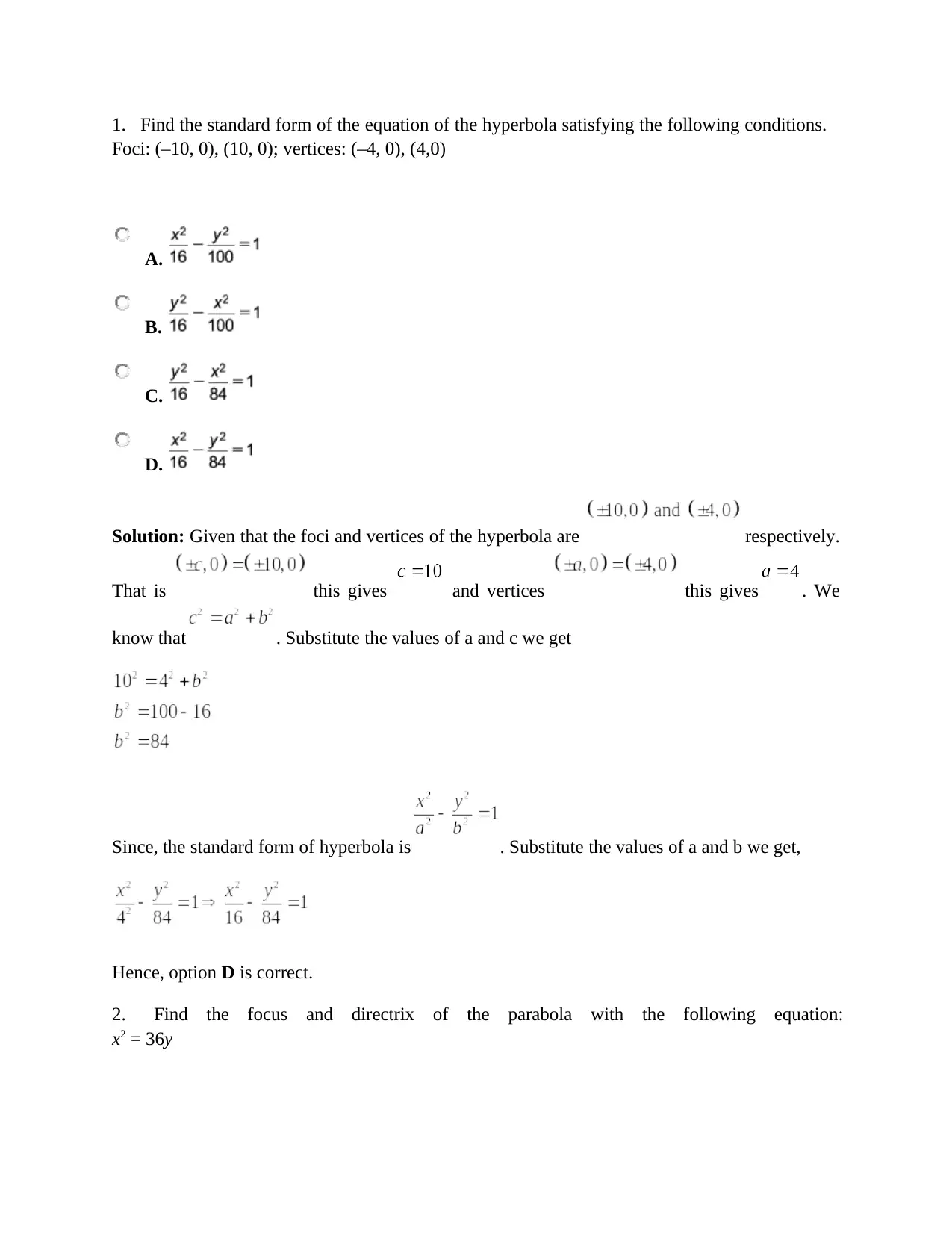
1. Find the standard form of the equation of the hyperbola satisfying the following conditions.
Foci: (–10, 0), (10, 0); vertices: (–4, 0), (4,0)
A.
B.
C.
D.
Solution: Given that the foci and vertices of the hyperbola are respectively.
That is this gives and vertices this gives . We
know that . Substitute the values of a and c we get
Since, the standard form of hyperbola is . Substitute the values of a and b we get,
Hence, option D is correct.
2. Find the focus and directrix of the parabola with the following equation:
x2 = 36y
Foci: (–10, 0), (10, 0); vertices: (–4, 0), (4,0)
A.
B.
C.
D.
Solution: Given that the foci and vertices of the hyperbola are respectively.
That is this gives and vertices this gives . We
know that . Substitute the values of a and c we get
Since, the standard form of hyperbola is . Substitute the values of a and b we get,
Hence, option D is correct.
2. Find the focus and directrix of the parabola with the following equation:
x2 = 36y
Paraphrase This Document
Need a fresh take? Get an instant paraphrase of this document with our AI Paraphraser
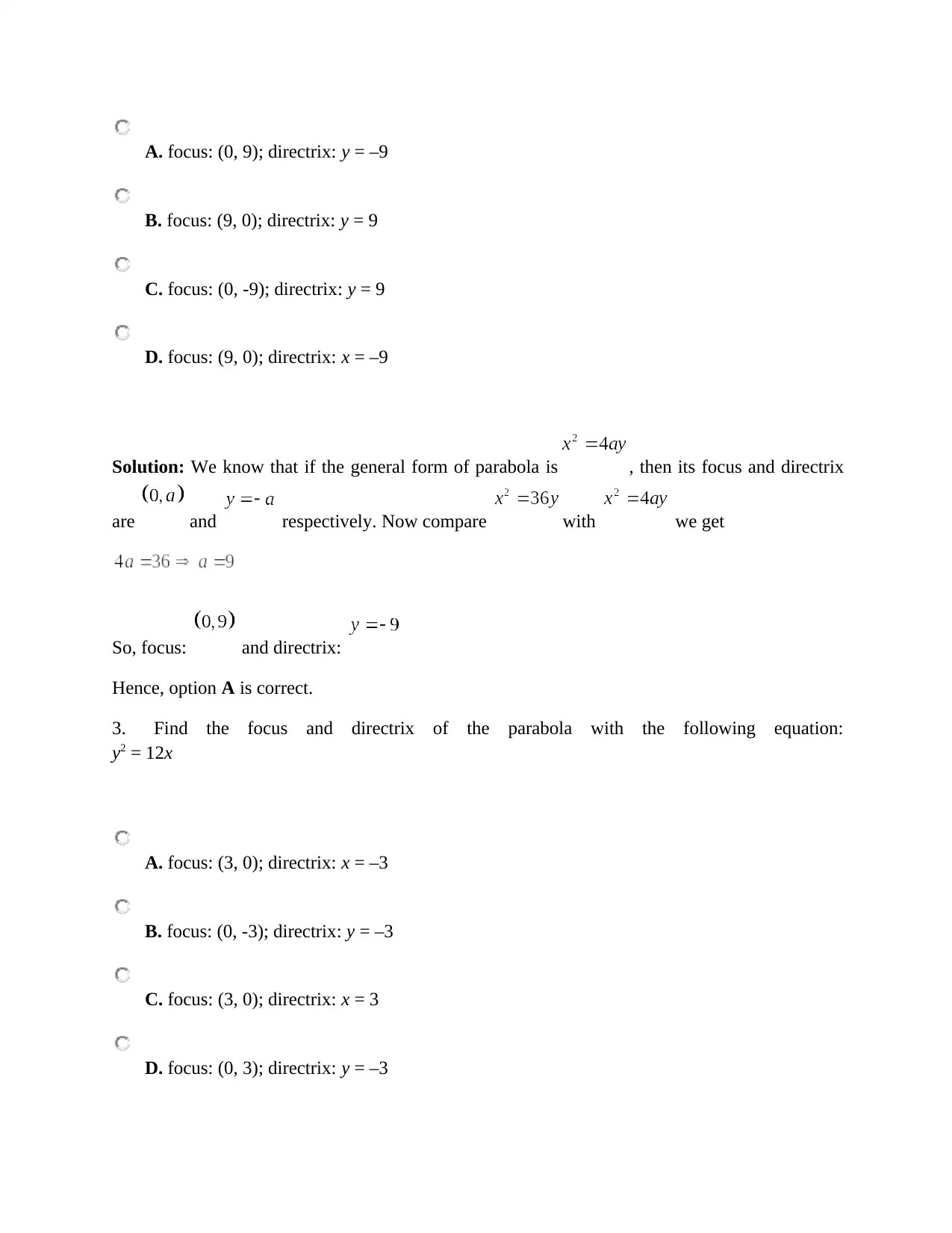
A. focus: (0, 9); directrix: y = –9
B. focus: (9, 0); directrix: y = 9
C. focus: (0, -9); directrix: y = 9
D. focus: (9, 0); directrix: x = –9
Solution: We know that if the general form of parabola is , then its focus and directrix
are and respectively. Now compare with we get
So, focus: and directrix:
Hence, option A is correct.
3. Find the focus and directrix of the parabola with the following equation:
y2 = 12x
A. focus: (3, 0); directrix: x = –3
B. focus: (0, -3); directrix: y = –3
C. focus: (3, 0); directrix: x = 3
D. focus: (0, 3); directrix: y = –3
B. focus: (9, 0); directrix: y = 9
C. focus: (0, -9); directrix: y = 9
D. focus: (9, 0); directrix: x = –9
Solution: We know that if the general form of parabola is , then its focus and directrix
are and respectively. Now compare with we get
So, focus: and directrix:
Hence, option A is correct.
3. Find the focus and directrix of the parabola with the following equation:
y2 = 12x
A. focus: (3, 0); directrix: x = –3
B. focus: (0, -3); directrix: y = –3
C. focus: (3, 0); directrix: x = 3
D. focus: (0, 3); directrix: y = –3
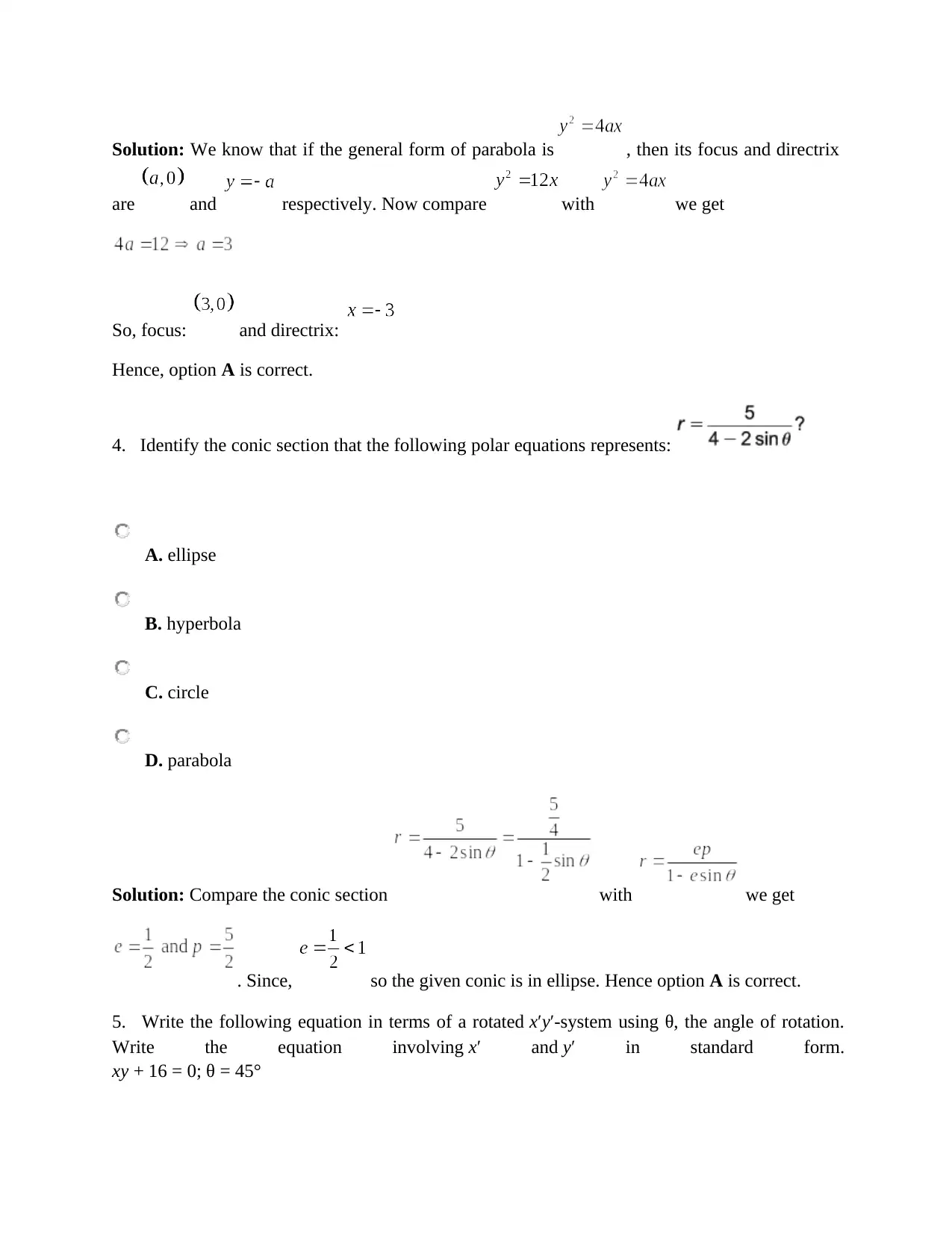
Solution: We know that if the general form of parabola is , then its focus and directrix
are and respectively. Now compare with we get
So, focus: and directrix:
Hence, option A is correct.
4. Identify the conic section that the following polar equations represents:
A. ellipse
B. hyperbola
C. circle
D. parabola
Solution: Compare the conic section with we get
. Since, so the given conic is in ellipse. Hence option A is correct.
5. Write the following equation in terms of a rotated x′y′-system using θ, the angle of rotation.
Write the equation involving x′ and y′ in standard form.
xy + 16 = 0; θ = 45°
are and respectively. Now compare with we get
So, focus: and directrix:
Hence, option A is correct.
4. Identify the conic section that the following polar equations represents:
A. ellipse
B. hyperbola
C. circle
D. parabola
Solution: Compare the conic section with we get
. Since, so the given conic is in ellipse. Hence option A is correct.
5. Write the following equation in terms of a rotated x′y′-system using θ, the angle of rotation.
Write the equation involving x′ and y′ in standard form.
xy + 16 = 0; θ = 45°
⊘ This is a preview!⊘
Do you want full access?
Subscribe today to unlock all pages.

Trusted by 1+ million students worldwide
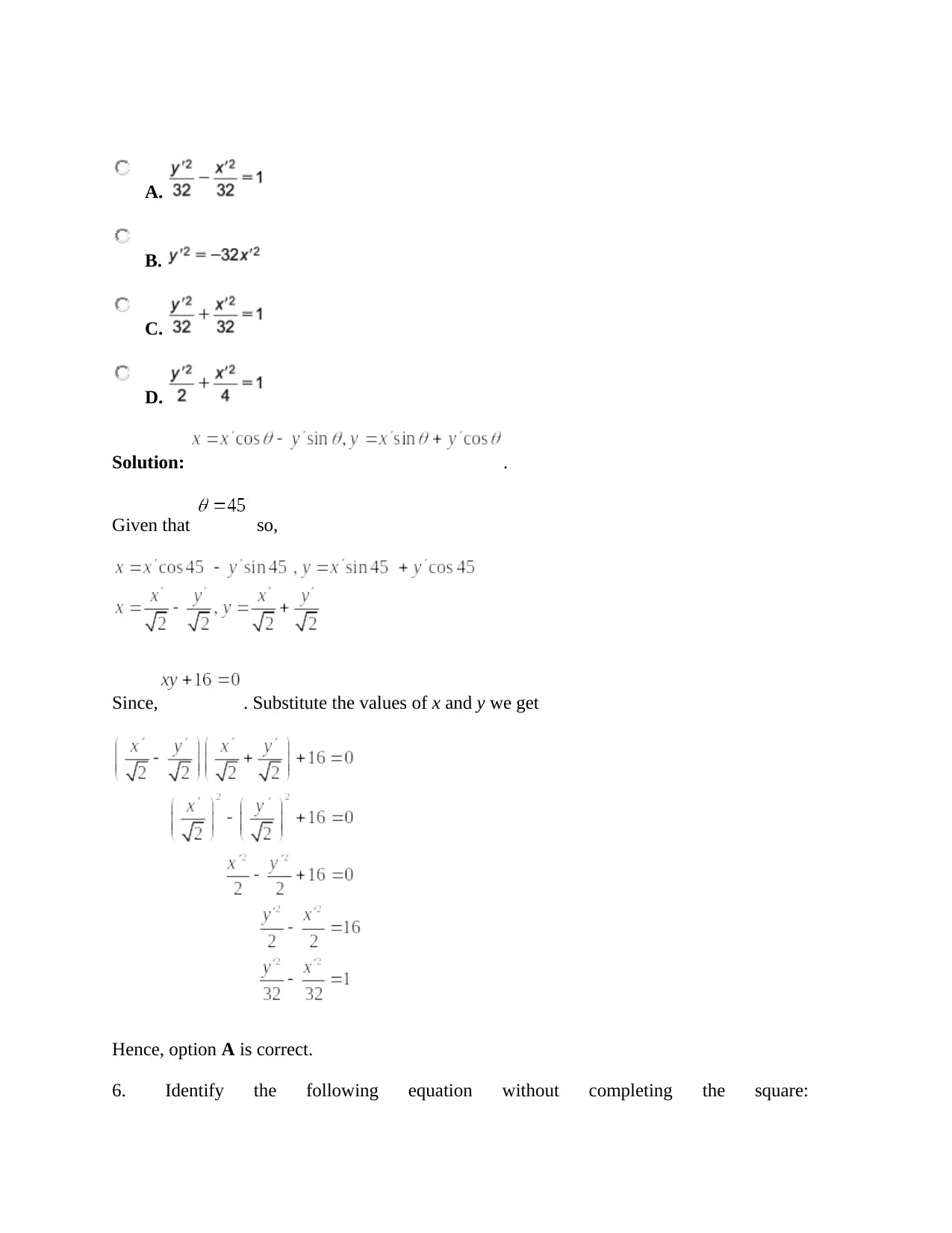
A.
B.
C.
D.
Solution: .
Given that so,
Since, . Substitute the values of x and y we get
Hence, option A is correct.
6. Identify the following equation without completing the square:
B.
C.
D.
Solution: .
Given that so,
Since, . Substitute the values of x and y we get
Hence, option A is correct.
6. Identify the following equation without completing the square:
Paraphrase This Document
Need a fresh take? Get an instant paraphrase of this document with our AI Paraphraser
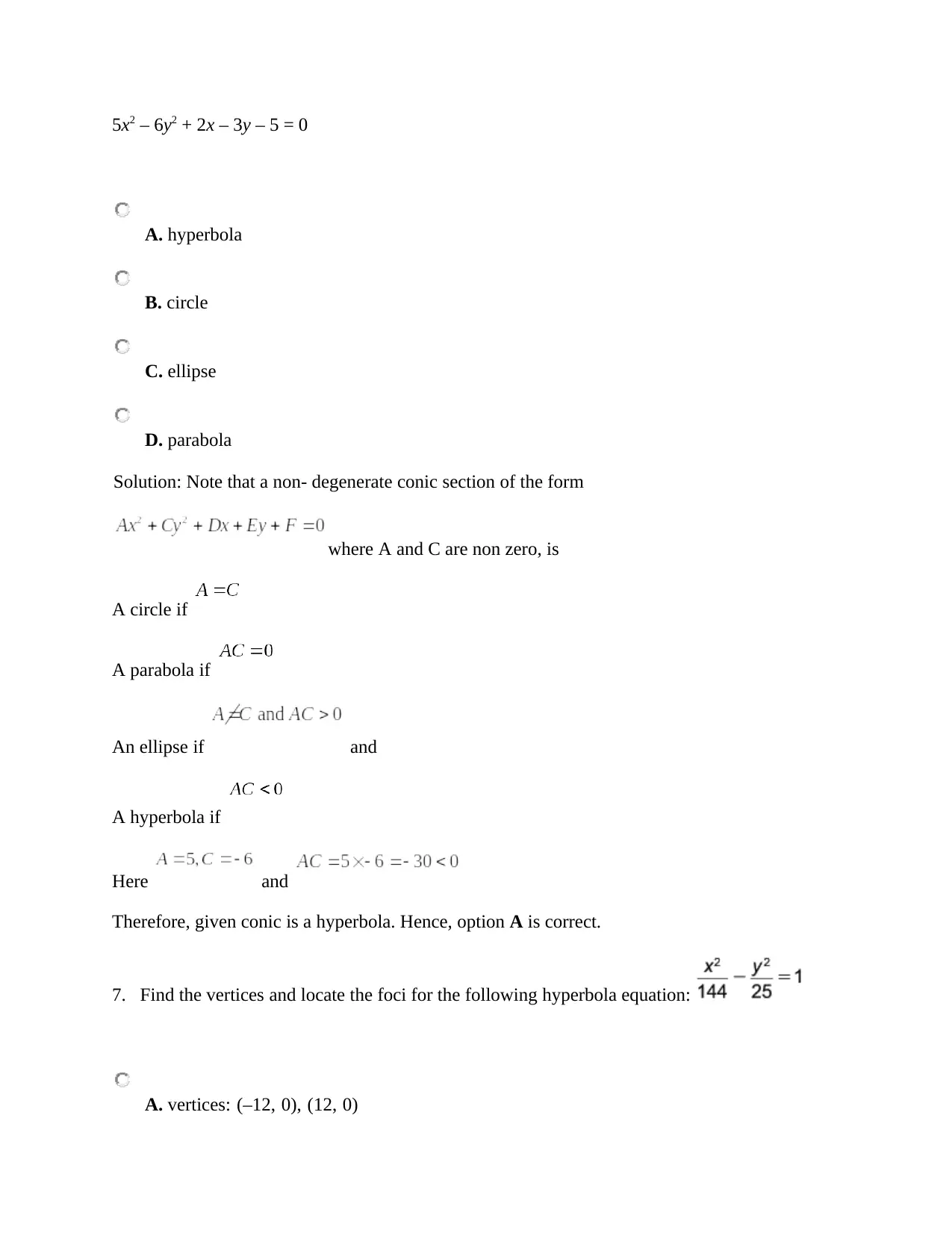
5x2 – 6y2 + 2x – 3y – 5 = 0
A. hyperbola
B. circle
C. ellipse
D. parabola
Solution: Note that a non- degenerate conic section of the form
where A and C are non zero, is
A circle if
A parabola if
An ellipse if and
A hyperbola if
Here and
Therefore, given conic is a hyperbola. Hence, option A is correct.
7. Find the vertices and locate the foci for the following hyperbola equation:
A. vertices: (–12, 0), (12, 0)
A. hyperbola
B. circle
C. ellipse
D. parabola
Solution: Note that a non- degenerate conic section of the form
where A and C are non zero, is
A circle if
A parabola if
An ellipse if and
A hyperbola if
Here and
Therefore, given conic is a hyperbola. Hence, option A is correct.
7. Find the vertices and locate the foci for the following hyperbola equation:
A. vertices: (–12, 0), (12, 0)
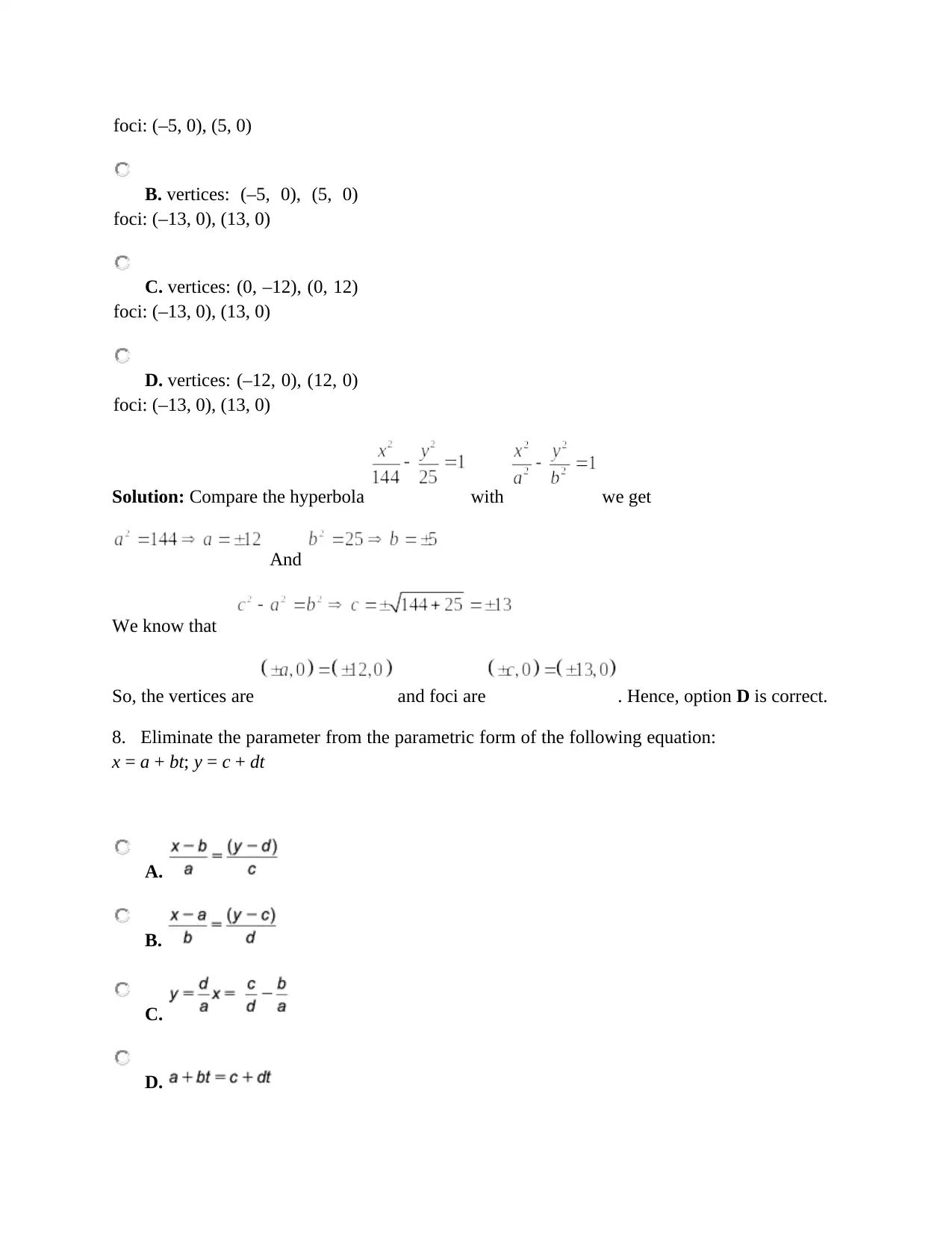
foci: (–5, 0), (5, 0)
B. vertices: (–5, 0), (5, 0)
foci: (–13, 0), (13, 0)
C. vertices: (0, –12), (0, 12)
foci: (–13, 0), (13, 0)
D. vertices: (–12, 0), (12, 0)
foci: (–13, 0), (13, 0)
Solution: Compare the hyperbola with we get
And
We know that
So, the vertices are and foci are . Hence, option D is correct.
8. Eliminate the parameter from the parametric form of the following equation:
x = a + bt; y = c + dt
A.
B.
C.
D.
B. vertices: (–5, 0), (5, 0)
foci: (–13, 0), (13, 0)
C. vertices: (0, –12), (0, 12)
foci: (–13, 0), (13, 0)
D. vertices: (–12, 0), (12, 0)
foci: (–13, 0), (13, 0)
Solution: Compare the hyperbola with we get
And
We know that
So, the vertices are and foci are . Hence, option D is correct.
8. Eliminate the parameter from the parametric form of the following equation:
x = a + bt; y = c + dt
A.
B.
C.
D.
⊘ This is a preview!⊘
Do you want full access?
Subscribe today to unlock all pages.

Trusted by 1+ million students worldwide
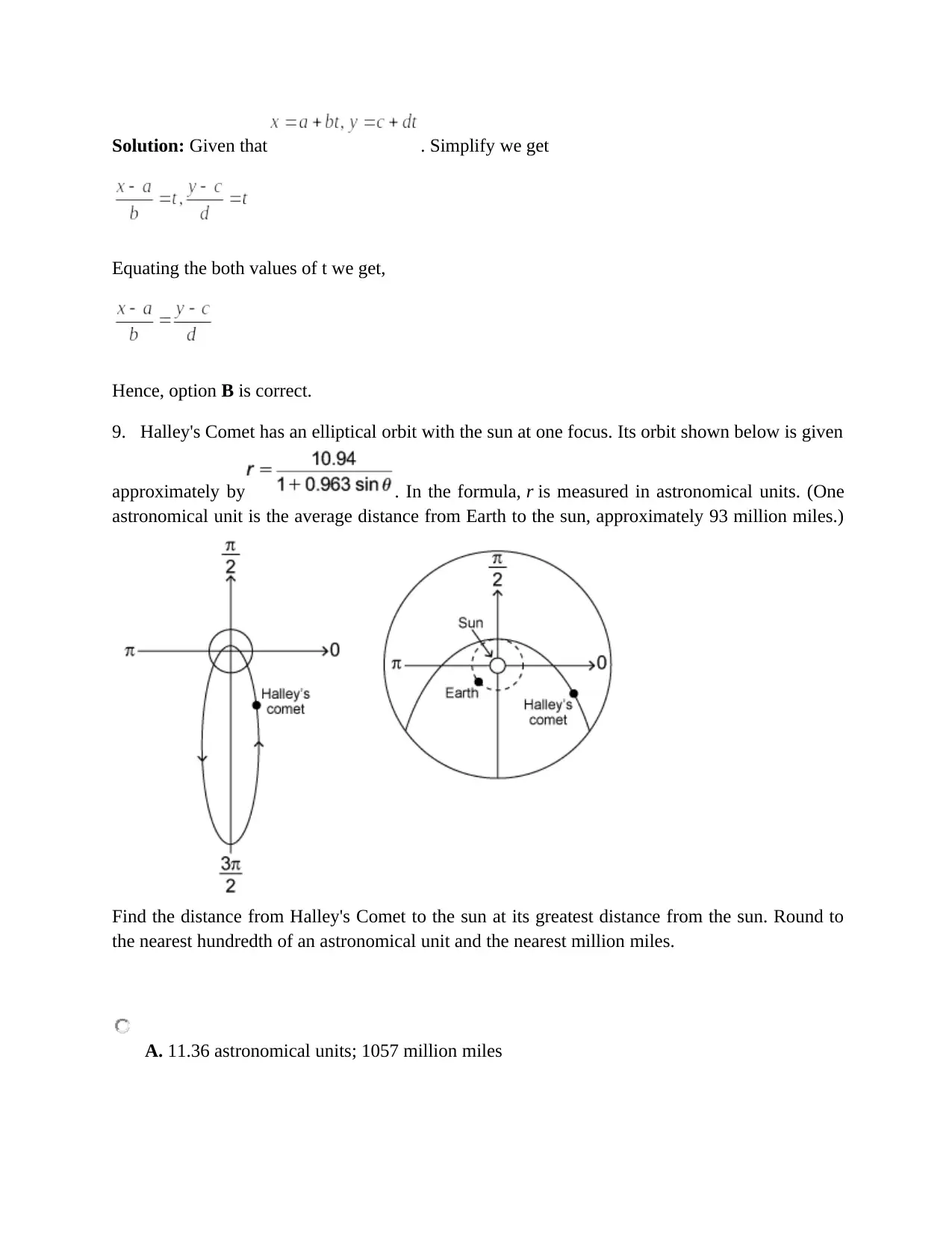
Solution: Given that . Simplify we get
Equating the both values of t we get,
Hence, option B is correct.
9. Halley's Comet has an elliptical orbit with the sun at one focus. Its orbit shown below is given
approximately by . In the formula, r is measured in astronomical units. (One
astronomical unit is the average distance from Earth to the sun, approximately 93 million miles.)
Find the distance from Halley's Comet to the sun at its greatest distance from the sun. Round to
the nearest hundredth of an astronomical unit and the nearest million miles.
A. 11.36 astronomical units; 1057 million miles
Equating the both values of t we get,
Hence, option B is correct.
9. Halley's Comet has an elliptical orbit with the sun at one focus. Its orbit shown below is given
approximately by . In the formula, r is measured in astronomical units. (One
astronomical unit is the average distance from Earth to the sun, approximately 93 million miles.)
Find the distance from Halley's Comet to the sun at its greatest distance from the sun. Round to
the nearest hundredth of an astronomical unit and the nearest million miles.
A. 11.36 astronomical units; 1057 million miles
Paraphrase This Document
Need a fresh take? Get an instant paraphrase of this document with our AI Paraphraser
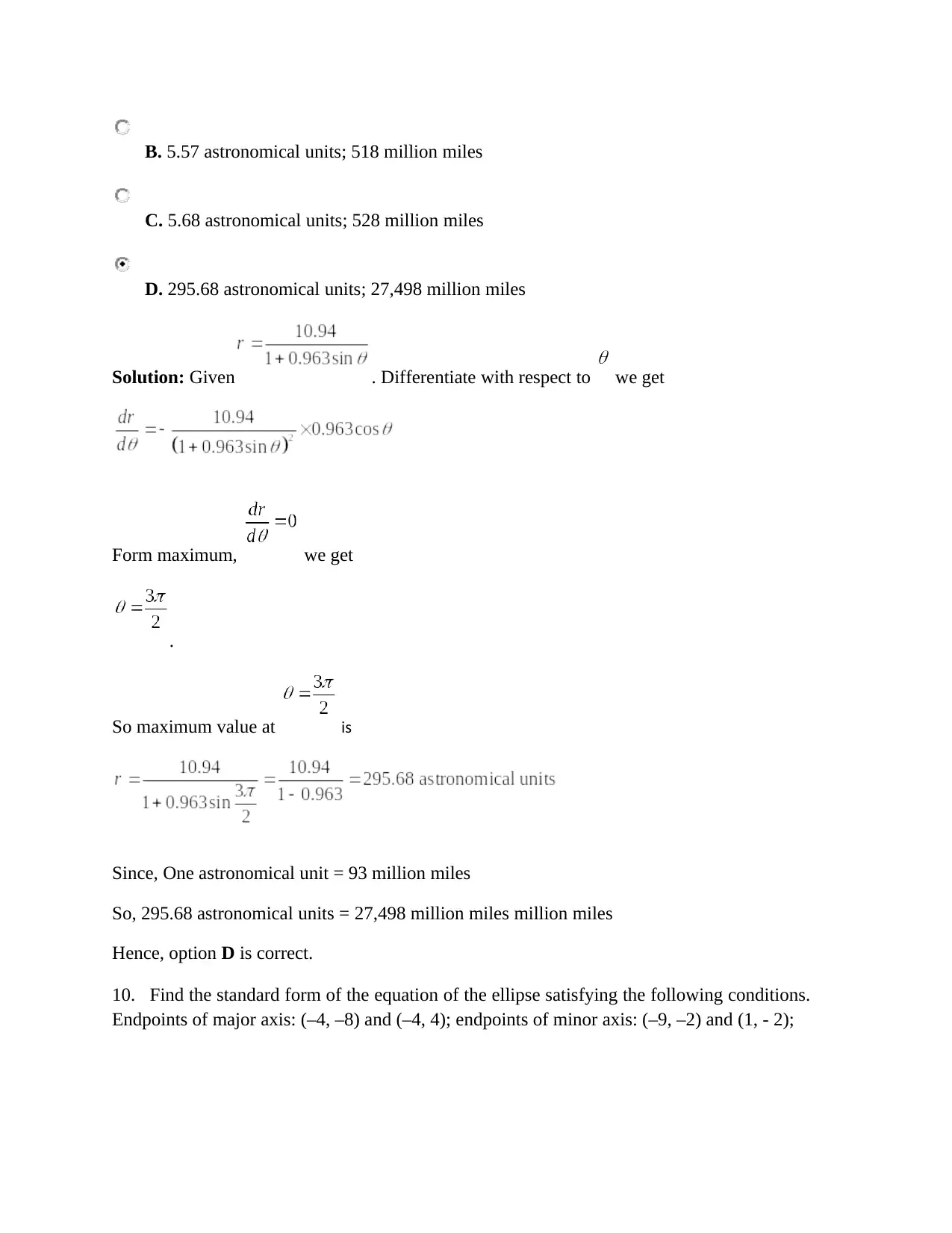
B. 5.57 astronomical units; 518 million miles
C. 5.68 astronomical units; 528 million miles
D. 295.68 astronomical units; 27,498 million miles
Solution: Given . Differentiate with respect to we get
Form maximum, we get
.
So maximum value at is
Since, One astronomical unit = 93 million miles
So, 295.68 astronomical units = 27,498 million miles million miles
Hence, option D is correct.
10. Find the standard form of the equation of the ellipse satisfying the following conditions.
Endpoints of major axis: (–4, –8) and (–4, 4); endpoints of minor axis: (–9, –2) and (1, - 2);
C. 5.68 astronomical units; 528 million miles
D. 295.68 astronomical units; 27,498 million miles
Solution: Given . Differentiate with respect to we get
Form maximum, we get
.
So maximum value at is
Since, One astronomical unit = 93 million miles
So, 295.68 astronomical units = 27,498 million miles million miles
Hence, option D is correct.
10. Find the standard form of the equation of the ellipse satisfying the following conditions.
Endpoints of major axis: (–4, –8) and (–4, 4); endpoints of minor axis: (–9, –2) and (1, - 2);
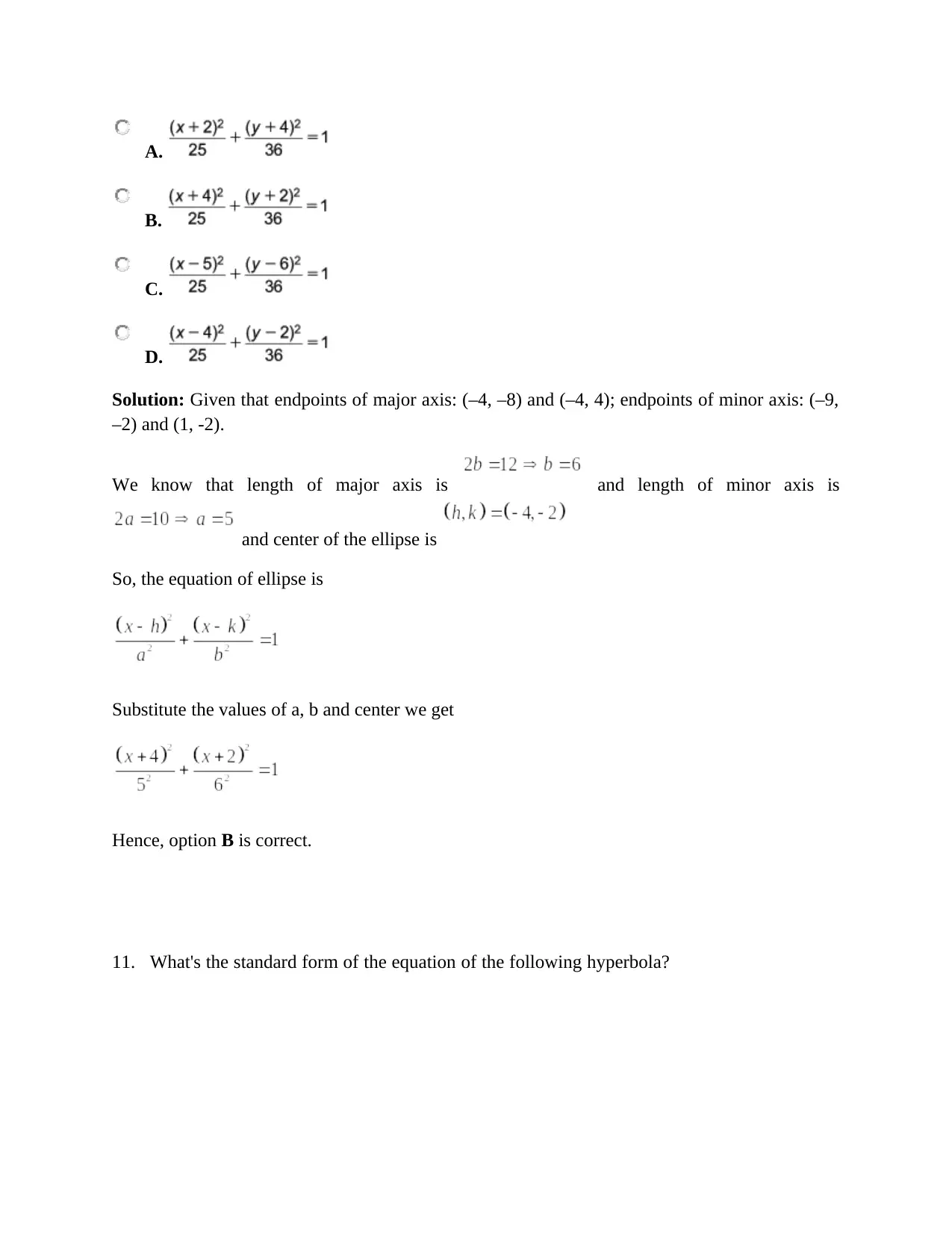
A.
B.
C.
D.
Solution: Given that endpoints of major axis: (–4, –8) and (–4, 4); endpoints of minor axis: (–9,
–2) and (1, -2).
We know that length of major axis is and length of minor axis is
and center of the ellipse is
So, the equation of ellipse is
Substitute the values of a, b and center we get
Hence, option B is correct.
11. What's the standard form of the equation of the following hyperbola?
B.
C.
D.
Solution: Given that endpoints of major axis: (–4, –8) and (–4, 4); endpoints of minor axis: (–9,
–2) and (1, -2).
We know that length of major axis is and length of minor axis is
and center of the ellipse is
So, the equation of ellipse is
Substitute the values of a, b and center we get
Hence, option B is correct.
11. What's the standard form of the equation of the following hyperbola?
⊘ This is a preview!⊘
Do you want full access?
Subscribe today to unlock all pages.

Trusted by 1+ million students worldwide
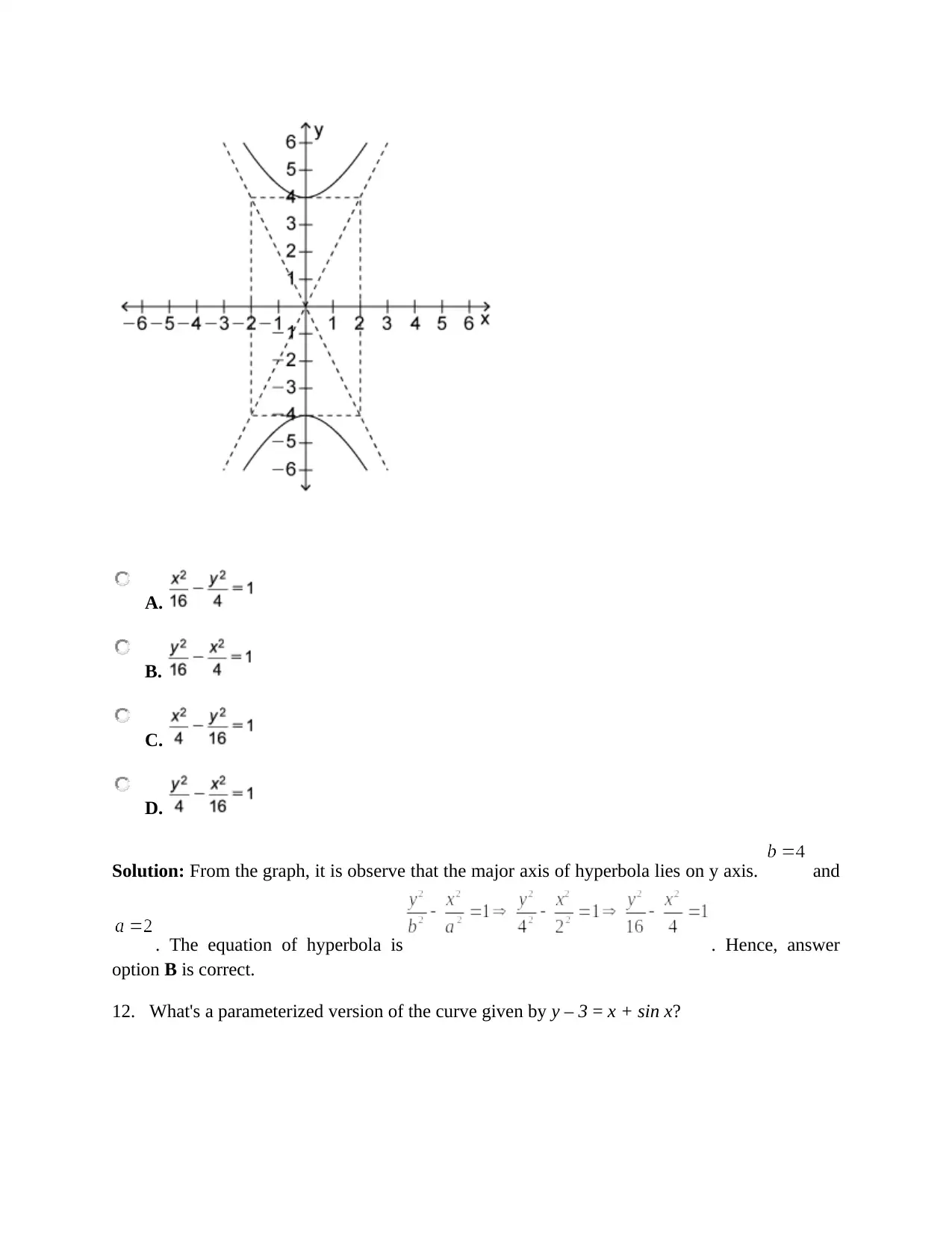
A.
B.
C.
D.
Solution: From the graph, it is observe that the major axis of hyperbola lies on y axis. and
. The equation of hyperbola is . Hence, answer
option B is correct.
12. What's a parameterized version of the curve given by y – 3 = x + sin x?
B.
C.
D.
Solution: From the graph, it is observe that the major axis of hyperbola lies on y axis. and
. The equation of hyperbola is . Hence, answer
option B is correct.
12. What's a parameterized version of the curve given by y – 3 = x + sin x?
Paraphrase This Document
Need a fresh take? Get an instant paraphrase of this document with our AI Paraphraser
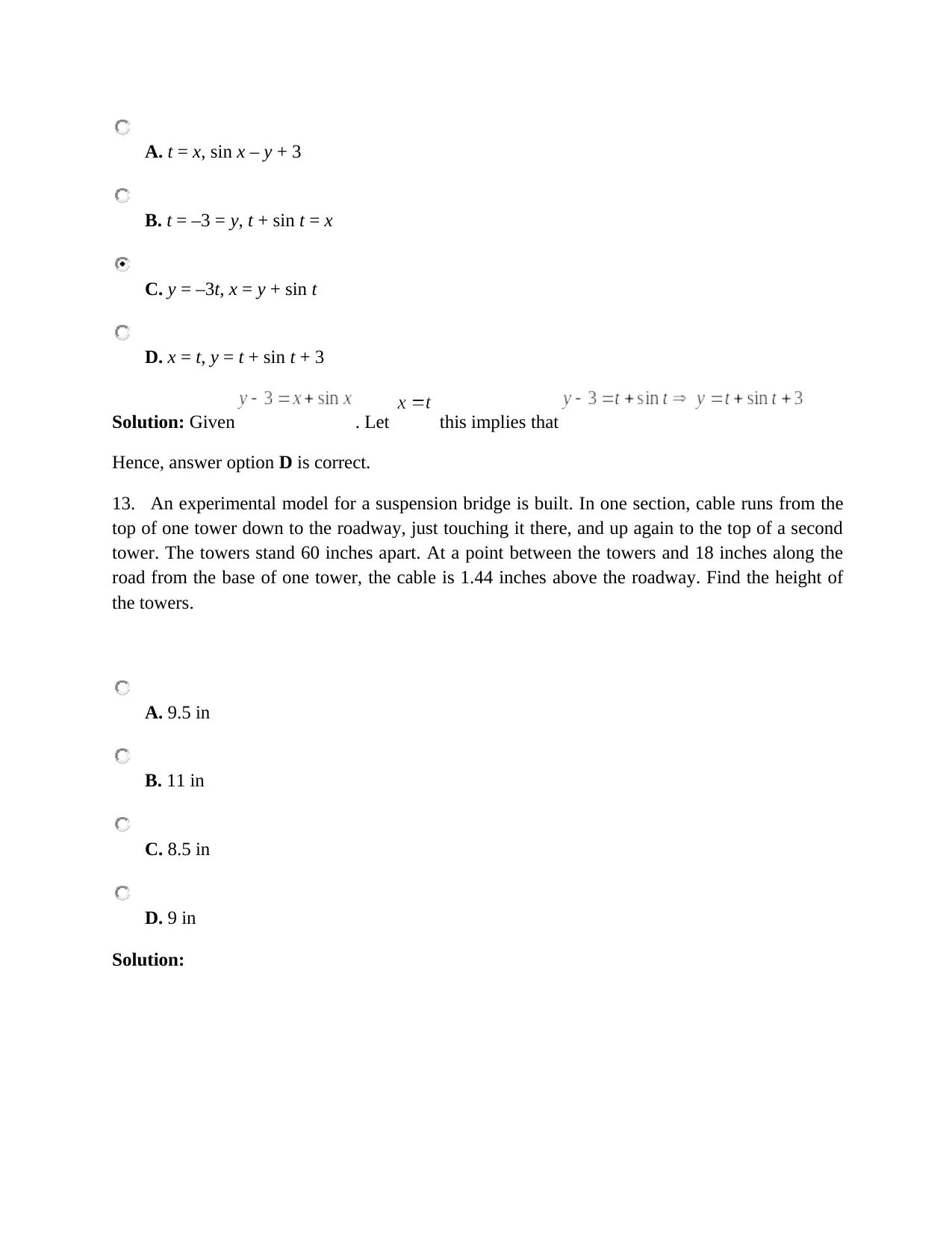
A. t = x, sin x – y + 3
B. t = –3 = y, t + sin t = x
C. y = –3t, x = y + sin t
D. x = t, y = t + sin t + 3
Solution: Given . Let this implies that
Hence, answer option D is correct.
13. An experimental model for a suspension bridge is built. In one section, cable runs from the
top of one tower down to the roadway, just touching it there, and up again to the top of a second
tower. The towers stand 60 inches apart. At a point between the towers and 18 inches along the
road from the base of one tower, the cable is 1.44 inches above the roadway. Find the height of
the towers.
A. 9.5 in
B. 11 in
C. 8.5 in
D. 9 in
Solution:
B. t = –3 = y, t + sin t = x
C. y = –3t, x = y + sin t
D. x = t, y = t + sin t + 3
Solution: Given . Let this implies that
Hence, answer option D is correct.
13. An experimental model for a suspension bridge is built. In one section, cable runs from the
top of one tower down to the roadway, just touching it there, and up again to the top of a second
tower. The towers stand 60 inches apart. At a point between the towers and 18 inches along the
road from the base of one tower, the cable is 1.44 inches above the roadway. Find the height of
the towers.
A. 9.5 in
B. 11 in
C. 8.5 in
D. 9 in
Solution:
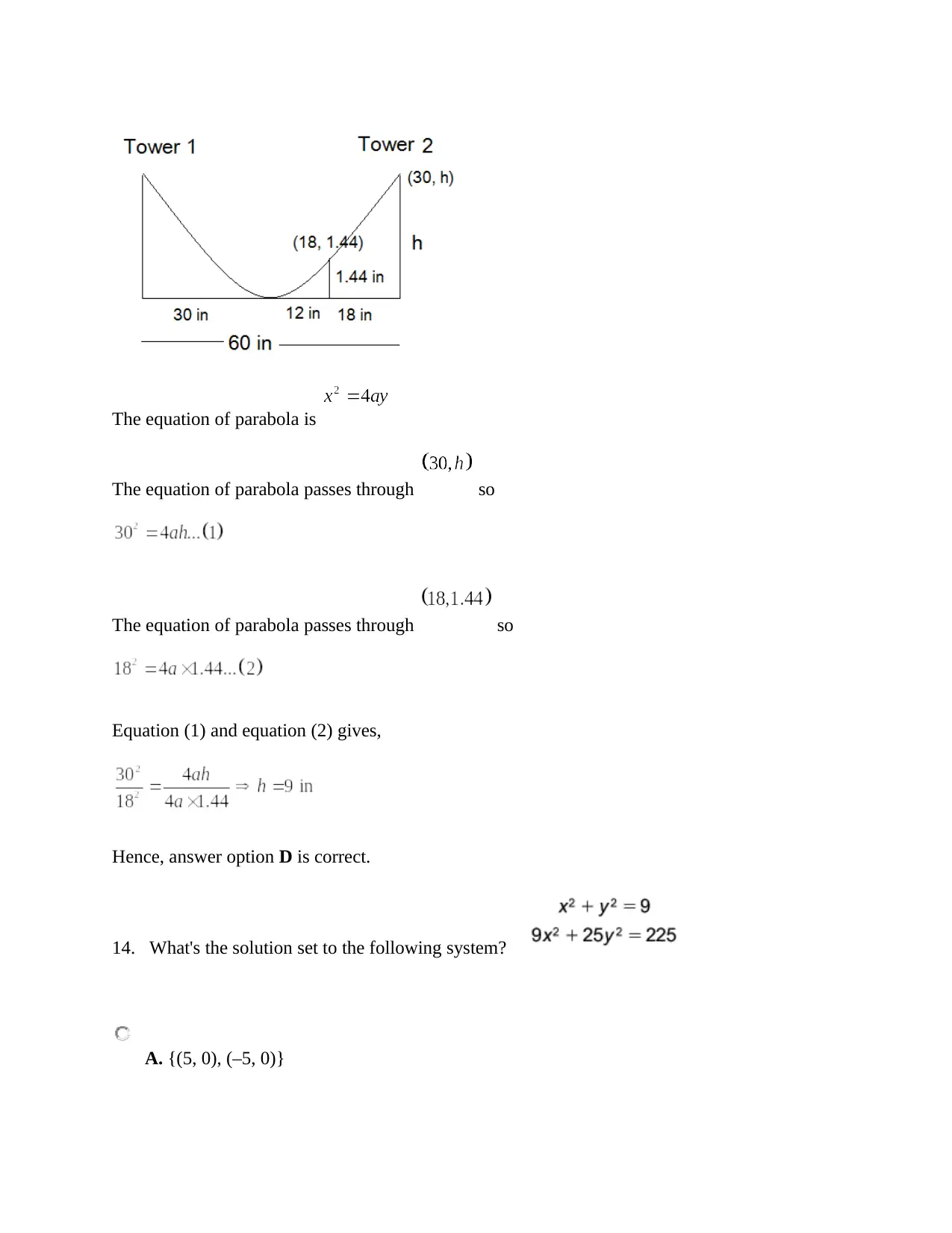
The equation of parabola is
The equation of parabola passes through so
The equation of parabola passes through so
Equation (1) and equation (2) gives,
Hence, answer option D is correct.
14. What's the solution set to the following system?
A. {(5, 0), (–5, 0)}
The equation of parabola passes through so
The equation of parabola passes through so
Equation (1) and equation (2) gives,
Hence, answer option D is correct.
14. What's the solution set to the following system?
A. {(5, 0), (–5, 0)}
⊘ This is a preview!⊘
Do you want full access?
Subscribe today to unlock all pages.

Trusted by 1+ million students worldwide
1 out of 19
Related Documents
Your All-in-One AI-Powered Toolkit for Academic Success.
+13062052269
info@desklib.com
Available 24*7 on WhatsApp / Email
![[object Object]](/_next/static/media/star-bottom.7253800d.svg)
Unlock your academic potential
Copyright © 2020–2025 A2Z Services. All Rights Reserved. Developed and managed by ZUCOL.




